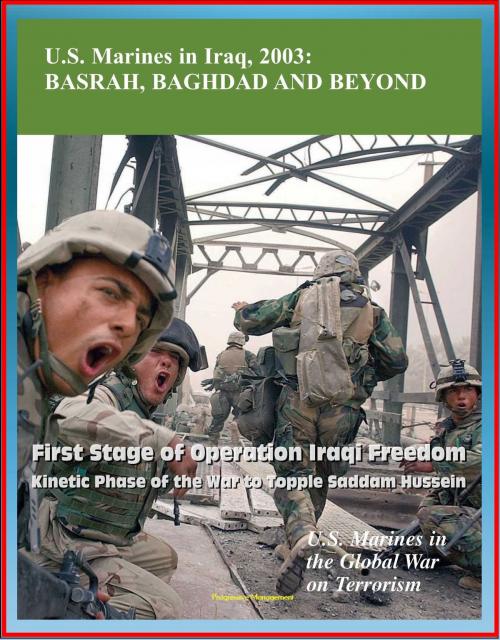U.S. Marines in the Global War on Terrorism: U.S. Marines in Iraq, 2003: Basrah, Baghdad and Beyond - First Stage of Operation Iraqi Freedom, Kinetic Phase of the War to Topple Saddam Hussein
Nonfiction, History, Military| Author: | Progressive Management | ISBN: | 9781301283972 |
| Publisher: | Progressive Management | Publication: | January 2, 2013 |
| Imprint: | Smashwords Edition | Language: | English |
| Author: | Progressive Management |
| ISBN: | 9781301283972 |
| Publisher: | Progressive Management |
| Publication: | January 2, 2013 |
| Imprint: | Smashwords Edition |
| Language: | English |
This book on the beginning of hostilities in Iraq is one of the first historical works commissioned by the History Division to focus on the role of the U.S. Marine Corps in the long war against global terrorism.
It is about Marines during the first stage of Operation Iraqi Freedom (OIF). It spans the period from 11 September 2001 to March and April 2003, when the Coalition removed Saddam Hussein from power, and concludes in November 2003 when the Marines left Kuwait to return to their home bases in the United States. While many then believed that the "kinetic" phase of the fighting in Iraq was largely over, as we now know, it was only a prelude to a longer but just as deadly phase of operations where Marines would be redeployed to Iraq in 2004 to combat insurgents (both foreign and domestic) who had filtered back into the country. However, this phase of the fighting would be very different from the one the Marines and U.S. Army had fought in the spring of 2003 in the march up to take Baghdad.
The primary focus of the book is I Marine Expeditionary Force (I MEF)—the runup to the war in 2002 and early 2003, especially the development of "the plan," with its many changes, the exhaustive rehearsals, and other preparations, and then the conduct of decisive combat operations and the immediate postwar period, mostly under the control of the U.S. Central Command's Coalition Forces Land Component Command. The book also touches upon other Marine activities in the Military Coordination and Liaison Command in northern Iraq and with the British in the south. Nonetheless, the primary focus remains on I Marine Expeditionary Force and the interactions of its constituent elements.
This book is a framework for understanding Marine participation in the Iraq War by describing how Marines coped with the set of challenges they faced in 2002 and 2003. Some of the implied lessons may turn out to be universal, such as the ways Marine staff officers worked in the joint arena. But some of the issues that were pressing in Iraq in March and April 2003 may turn out to be irrelevant in other times and places, except in the sense that past is prologue, that we need to understand where we have been if we want to understand where we are.
This book on the beginning of hostilities in Iraq is one of the first historical works commissioned by the History Division to focus on the role of the U.S. Marine Corps in the long war against global terrorism.
It is about Marines during the first stage of Operation Iraqi Freedom (OIF). It spans the period from 11 September 2001 to March and April 2003, when the Coalition removed Saddam Hussein from power, and concludes in November 2003 when the Marines left Kuwait to return to their home bases in the United States. While many then believed that the "kinetic" phase of the fighting in Iraq was largely over, as we now know, it was only a prelude to a longer but just as deadly phase of operations where Marines would be redeployed to Iraq in 2004 to combat insurgents (both foreign and domestic) who had filtered back into the country. However, this phase of the fighting would be very different from the one the Marines and U.S. Army had fought in the spring of 2003 in the march up to take Baghdad.
The primary focus of the book is I Marine Expeditionary Force (I MEF)—the runup to the war in 2002 and early 2003, especially the development of "the plan," with its many changes, the exhaustive rehearsals, and other preparations, and then the conduct of decisive combat operations and the immediate postwar period, mostly under the control of the U.S. Central Command's Coalition Forces Land Component Command. The book also touches upon other Marine activities in the Military Coordination and Liaison Command in northern Iraq and with the British in the south. Nonetheless, the primary focus remains on I Marine Expeditionary Force and the interactions of its constituent elements.
This book is a framework for understanding Marine participation in the Iraq War by describing how Marines coped with the set of challenges they faced in 2002 and 2003. Some of the implied lessons may turn out to be universal, such as the ways Marine staff officers worked in the joint arena. But some of the issues that were pressing in Iraq in March and April 2003 may turn out to be irrelevant in other times and places, except in the sense that past is prologue, that we need to understand where we have been if we want to understand where we are.















